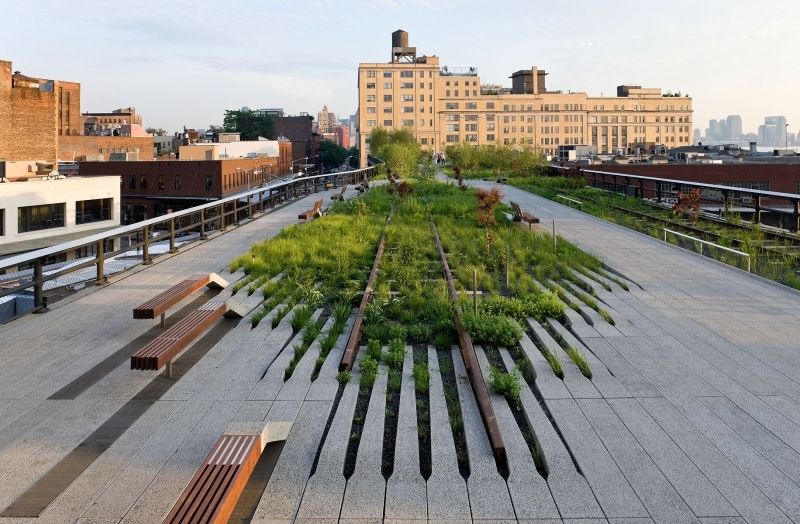Guess what street it is? 14th Street! And it makes sense; from the residential maze of Stuy Town to bustling Union Square to the tourist trap High Line and post-industrial Meatpacking, there are few streets in Manhattan as diverse as 14th Street. Here’s Brendan O’Connor for the Awl, in partial, below. The full piece here.
Manhattan’s 14th Street is never a pleasant place to be, but there are few streets that one can comfortably walk from end to end on a hot, late summer afternoon whereupon the full blossoming of capital is more radiantly displayed. There is an idea of New York, and especially of Manhattan, as a place where the wealthy and the less wealthy (and even the not-at-all wealthy!) live in close proximity, even adjacent, to each other, and that this arrangement produces ambition in the latter to attain what the former has, and some amount of respect for the humanity of the latter in the former. This is not just incidental to life here, the thinking goes, but integral to it: Everyone, or almost everyone, suffers the city together.
At least as far as most pedestrians are concerned, 14th Street’s westernmost terminus is the High Line, an elevated, linear park built on a disused, mile-and-a-half long section of the West Side Freight Line. There is a set of stairs up to the railroad track a few steps past an enormous Diane von Furstenberg store. Von Furstenberg, a high-end fashion designer, and her billionaire husband, Barry Diller, donated upwards of thirty-five million dollars towards the completion of the High Line. (Von Furstenberg and Diller have also pledged one hundred thirty million dollars to refurbish nearby Pier 54, in the Hudson River.)
The stretch of 14th Street between the High Line and 8th Avenue is heavily oriented towards retail, which is perhaps unsurprising, given that the High Line attracts at least five million visitors annually. (A smart investment on Von Furstenberg’s part, then!) But the High Line is a magnet for more than tourists’ money: According to a study conducted by the New York City Economic Development Corporation, before the park’s construction in 2003, the surrounding West Chelsea neighborhood—a mix of residential properties and light industrial businesses—were valued at eight percent below Manhattan’s overall median. In 2005, the city rezoned West Chelsea for luxury development, and, by 2011, residential property values appreciated beyond borough-wide values. “The park, which will eventually snake through more than twenty blocks, is destroying neighborhoods as it grows,” Jeremiah Moss wrote in the New York Times in 2012. “And it’s doing so by design. While the park began as a grass-roots endeavor—albeit a well-heeled one—it quickly became a tool for the Bloomberg administration’s creation of a new, upscale, corporatized stretch along the West Side.” Price per square foot for residential units within five minutes walking distance of the High Line more than doubled in less than a decade.
A random selection, from Streeteasy, of rental apartments in the High Line’s immediate area: a fourteen-thousand-dollar-a-month two-bedroom condo “on the cross road of Manhattan’s ultra stylish Meat Packing District, Chelsea and the West Village“; a thirty-three-hundred one-bedroom apartment with no broker fee; a twenty-seven-hundred-dollar-per-month one bedroom above Solstice Sunglasses. As one walks east along 14th Street, away from the High Line, out of the cobblestone and into the pavement, there are fewer high-end brands (DVF; Chanel; Fjallraven) and more shops whose wares seem more expensive than they should be, but not so expensive that you can’t not convince yourself that maybe they are somehow worth it: Kiehl’s, Patagonia, Levi’s. Also: Apple.
Eighth Avenue is the last stop on the L train, which rattles beneath 14th Street, intersecting with the A/C/E at Eighth Avenue, the F/M and 1/2/3 at Sixth Avenue, and the N/Q/R and 4/5/6 at Union Square. The Sixth Avenue subway station, which could really also be called the Seventh Avenue subway station, is matched only in its labyrinthine sprawl by the West Side Market just above. Between Eighth Avenue and Sixth Avenue is a hodgepodge of bars and bodegas; the Local 237 Teamsters union building sits across the street from a nail salon called “Yo Yo Spa.” Homeless folks sleep on the steps of the enormous Salvation Army executive headquarters. Rental apartments in the area are listed at essentially the same price range as a few blocks west: a three bedroom for twelve grand a month; a one bedroom for nearly thirty-eight hundred dollars; and a three-thousand-dollar one bedroom.
